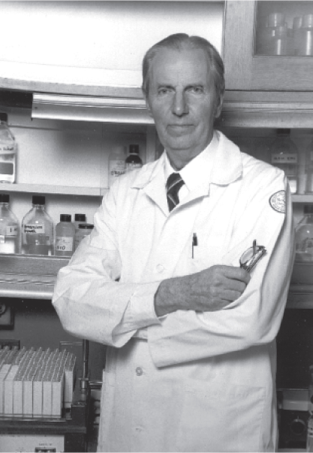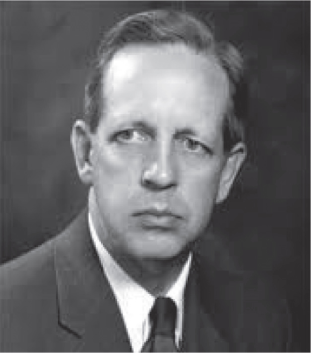Scroll to:
TAMM HORSFALL PROTEIN: THE MEN BEHIND THE EPONYM
https://doi.org/10.24884/1561-6274-2019-23-2-117-119
Abstract
Tamm–Horsfall Protein (uromodulin) is named after Igor Tamm and Franc Horsfall Jr who described it for the first time in 1952. It is a glycoprotein, secreted by the cells in the thick ascending limb of the loop of Henle. This protein will perform a number of important pathophysiological functions, including protection against uroinfections, especially caused by E. Сoli, and protection against formation of calcium concernments in the kidney. Igor Tamm (1922-1995) is an outstanding cytologist, virologist and biochemist. He is one of the pioneers in the study of viral replication. He was born in Estonia and died in the USA. In 1964 he was elected for a professorship in Rockefeller Institute for Medical Research, where has been working continuously. Since 1959, he became a head of the virology lab established by his mentor and co-author Franc Horsfall. In the course of studies on the natural inhibitor of viral replication, Tamm and Horsfall isolated and characterized biochemically a new protein named after their names. Franc Lappin Horsfall Jr (1906-1971) was a well-known clinician and virologist with remarkable achievements in internal medicine. He was born and died in the USA. He worked in the Rockefeller Hospital from 1934 to 1960, then in the Center for Cancer Research at the Sloan-Kettering Institute. Here he was a leader of a research team studying the molecular mechanisms of immunity, the effects of chemotherapy with benzimidazole compounds (together with I. Tamm), coxsackie viruses, herpes simplex virus, etc.
For citations:
Paskalev D.N., Galunska B.T., Petkova-Valkova D. TAMM HORSFALL PROTEIN: THE MEN BEHIND THE EPONYM. Nephrology (Saint-Petersburg). 2019;23(2):117-119. https://doi.org/10.24884/1561-6274-2019-23-2-117-119
Tamm Horsfall Protein - Brief data
Tamm-Horsfall Protein (THP) is named after Igor Tamm (1922-1995) and Franc Horsfall Jr (19061971) who described it for the first time in 1952 [1, 2]. The THP protein is an eponym of uromodulin, a glycoprotein, secreted by the cells in the thick ascending limb of the loop of Henle. It is encoded by a gene located on the 16-th chromosome (UMOD-gene). THP is composed of 616 amino acids and with molecular mass of about 90 kDa. It is found between 8-16 gestational week in the embryonal kidney and in am- niotic fluid. THP is excreted in the urine of healthy individuals at a rate of about 50 mg/day.
The major pathophysiological roles of THP include [3-5]:
- Protective functions against uroinfections, especially caused by Coli (trapping the pathogen’s pili)
- Potential protector against formation of calcium concrements in the kidney (antilithogenic factor)
- Possible role in the tubular interstitial injuries in different kidney diseases (tubulointerstitial nephritis), tubulitis in response to transplant rejection and others.
- In myelomic nephropathy, THP forms complexes with Bence Jones protein, which in consequence form large cylinders and are involved in the pathogenesis of tubular obstruction and peritubular (interstitial) inflammatory response.
- Defects in UMOD gene leading to development of medullary cystic disease (II-type) and familial juvenile hyperuricemic nephropathy, known as uro- modulin-related diseases.
Tamm and Horsfall: Brief biographic data
Igor Tamm is an outstanding cytologist, virologist and biochemist (Fig.1.). He is one of the pioneers in the study of viral replication. Igor Tamm was born on April 27, 1922 in Tapa, Estonia. His father was an architect who died early. Later, after his establishment in the United States, Tamm’s mother was a longtime associate of the American Geographic Society. Initially I. Tamm studied at the English State College in Tallinn. Afterwards he graduated medicine (1942-1943) at the Medical faculty of Tartu University, Estonia. During the Second World War, he managed to escape from the Estonia to Stockholm, Sweden, where he continued his medical education in the Karolinska Institute. He graduated medicine in Yale University, USA in 1947. After two-year specialization in Internal Medicine, he started his career as a medical doctor and scientist at the Rockefeller Institute for Medical Research. Igor Tamm has been working continuously in this worldrenowned scientific institution. In 1964 he was elected for a professorship. Since 1959, he became a head of the virology lab established by his mentor and co-author Franc Horsfall. In 1992, Igor Tamm became a professor emeritus at the same institution.
Igor Tamm has special merits in the field of virology and cell biology. In the course of studies on the natural inhibitor of viral replication, Tamm and Horsfall isolated and characterized biochemically a new protein named after their names. THP is the first isolated competitive inhibitor of viral adsorption (first step in the development of viral infection), and a substrate of the enzyme neuraminidase breaking down the influenza viruses. I. Tamm was a member of a research team who have thoroughly studied poliomyelitis virus as well as the genetic heterogeneity of the influenza virus. For 20 years, the team led by I. Tamm was conducting research on interferon, interleukins and other cytokines involved in carcinogenesis. His latest publication states that interleukin-6 (IL-6) reduces cell adhesion in ductal breast carcinoma.

Figure 1. Igor Tamm (1922-1995).
I. Tamm and F. Horsfall issued the monograph "Viral and Rickettsia Human Infections", which becomes a desktop reading for generations of professionals and endures several editions. I. Tamm collaborated in various scientific Journals in Immunology, Experimental medicine and immunology. He was a member of the American National Academy of Science (1975) and was awarded by the New York Academy of Sciences. He was the first American scientist awarded by the Alfred Bezon Swedish award "in recognition for his outstanding research on the replication of viruses." Alfred Bezon, a Maecenas and a sponsor of numerous medical and pharmaceutical research studies, was a founder of the first pharmaceutical company in Sweden in 1863.
I. Tamm was a polyglot, perfectly fluent in Estonian, Russian, English, German and Swedish languages. He married Olive E. Pitkin, a well-known pediatrician. The great scientist died on February 6, 1995 from prolonged chronic lung disease [6].

Figure 2. Franc Horsfall (1906-1971).
Franc Lappin Horsfall, Jr was a well-known clinician and virologist with remarkable achievements in internal medicine (Fig.2). F. Horsfall was born on 14.12.1906 in Seattle, Washington, in a family of a well-known surgeon. He initially intended to become an engineer, but later sets out in the footsteps of his father. He studied medicine (1927-1932) in Montreal, Canada, and graduated with a gold medal named after Andew Holmes (1797-1860), the founder of the first Medical school in Canada. Initially, Horsfall specialized pathology in Boston in the famous Peter Bent Brigham hospital, named after a businessman and a philanthropist, who donated a money for building a "hospital for poor patients“. F. Horsfal developed a severe allergy to formalin, which impeded his career as a pathologist and as a surgeon. At the end of 1934 he joined the Rockefeller Institute, which became his workplace over the next 25 years. At that time the hospital at the Institute was in its zenith and attracted young doctors for scientific and clinical specialization. F. Horsfall began studies on pneumococcal capsular polysaccharides and the production of antibodies ("antisera") against them in different animals. He succeeded in detecting a higher efficiency of rabbit antisera compared to those obtained from horses. These antisera application was widely used in clinical practice to treat pneumonia. Later, the pneumococcal antiserum therapy was displaced by the Prontosil, a sulfonamide medication developed and introduced by the German physician and bacteriologist Gerhard Domagk (1895-1965).
After 1937 F. Horsfall’s studies were focused on virology and influenza virus. Meanwhile, for 6 months each Sunday he worked with Arne Tiselius (1902-1971), a future Nobel prize winner on electrophoresis of macromolecules. Later, he took part in the so-called "complex" influenza vaccine applied in Great Britain during the Second World War. F. Hors- fall's latest research career took place at the Center for Cancer Research at the Sloan-Kettering Institute (Alfred Sloan - a philanthropist and a patron; Charles Kettering, an engineer, holder of 185 patents and a vice president of General Motors). Here he was a leader of a research team studying the molecular mechanisms of immunity, the effects of chemotherapy with benzimidazole compounds (together with I. Tamm), coxsackie viruses, herpes simplex virus, etc. F.Horsfall was one of the first researchers who payed attention to the so-called atypical pneumonias. He has been awarded various awards: Eli Lilly Award (1937), - the oldest and most prestigious American Microbiological Association Award for Bacteriology and Immunology; the American Philosophy Association Award (1959); a gold medal jubilee at Peter Bent Brigham Hospital (1936) and others. F. Horsfall was a member of many scientific organizations: the American Academy of Arts and Sciences, the American Association of Philosophy, the American Society for Clinical Trials, the American Physician Association, the American Association of Immunologists, of which he was president in 1967. He was an author and a co-author of more than 200 publications.
F. Horsfall married with Norma Campagnari, a nurse. From their marriage three children were born. Franc Lappin Horsfall Jr, died of cancer on 19.02.1971 [7].
About the Authors
D. N. PaskalevBulgaria
Assoc. prof. Dr., PhD, MD. Medical University “Prof. Dr. Paraskev Stoyanov” – Varna, Medical College, Department "Medical laboratory assistant", associate professor
B. T. Galunska
Bulgaria
Prof. Galunska Bistra Tzaneva, PhD. Medical University “Prof. Dr. Paraskev Stoyanov” – Varna, Department of Biochemistry, Molecular Medicine and Nutrigenomics, professor
D. Petkova-Valkova
Bulgaria
Assoc. prof. Dr. , PhD, MD. University Hospital at the Medical University “Prof. Dr. Paraskev Stoyanov” – Varna, Department "Internal Medicine", associate professor.
Review
For citations:
Paskalev D.N., Galunska B.T., Petkova-Valkova D. TAMM HORSFALL PROTEIN: THE MEN BEHIND THE EPONYM. Nephrology (Saint-Petersburg). 2019;23(2):117-119. https://doi.org/10.24884/1561-6274-2019-23-2-117-119








































